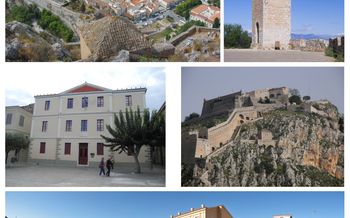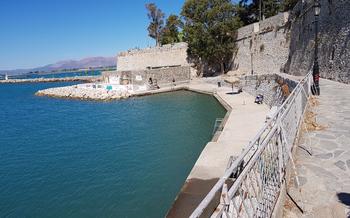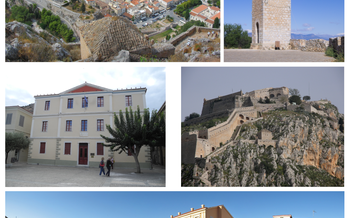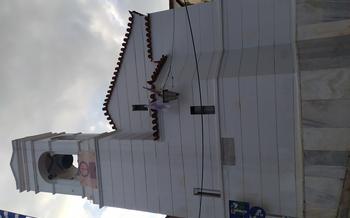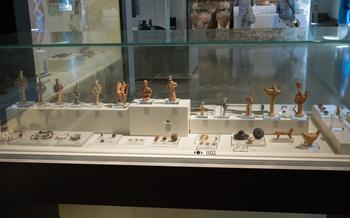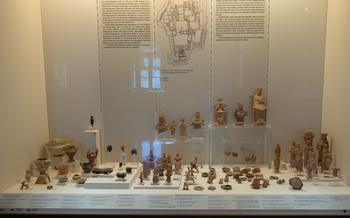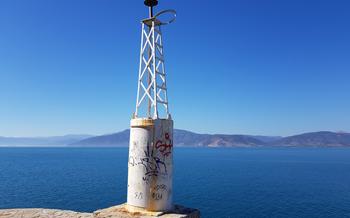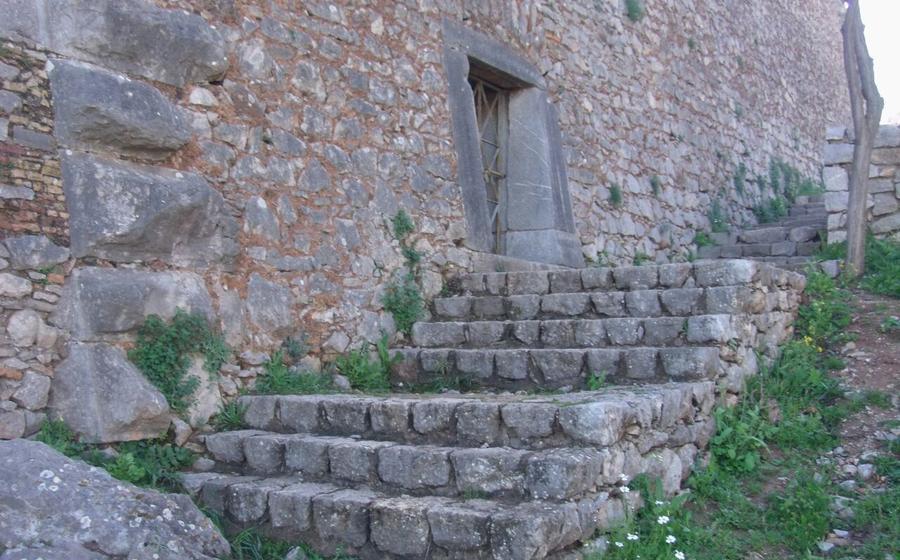
Agios Vasileios Church
- The Church of Agios Vasileios: A Historical Overview
- Location and Getting There
- Visiting Hours and Admission
- Exploring the Church's Exterior
- Stepping Inside the Church
- The Iconostasis: A Work of Art
- The Church's Connection to Saint Basil
- Religious Ceremonies and Services
- Historical Significance Beyond Religion
- Combining History with a Stroll
- Capturing the Essence through Photography
- Local Traditions and Beliefs
- The Church as a Symbol of Resilience
- Tips for a Fulfilling Visit
- Insider Tip: Hidden Gems Nearby
The Church of Agios Vasileios: A Historical Overview
Nestled in the heart of Nafplio, the picturesque capital of Argolis, Greece, stands the historic Church of Agios Vasileios, an architectural gem that holds a profound religious, cultural, and historical significance. Founded in the mid-18th century, the church boasts a unique blend of Byzantine and Venetian architectural styles, reflecting the diverse influences that have shaped Nafplio's rich heritage. The church's construction was initiated by the Greek Orthodox community, who sought to establish a place of worship amidst the growing city. Dedicated to Saint Basil the Great, one of the most revered saints in the Eastern Orthodox Church, the church quickly became a spiritual and cultural hub for the local population.
Beyond its religious significance, the Church of Agios Vasileios played a pivotal role in the Greek War of Independence, serving as a refuge and sanctuary for Greek fighters and civilians seeking shelter from Ottoman oppression. Its strategic location within the city walls made it an ideal gathering place for clandestine meetings and the coordination of resistance activities. The church's contribution to the struggle for independence earned it a special place in the hearts of the Greek people, solidifying its status as a symbol of national pride and resilience.
Location and Getting There
The Church of Agios Vasileios is situated in the heart of Nafplio's Old Town, making it easily accessible on foot. To find it, simply head to the central Syntagma Square and follow the picturesque cobbled streets towards the west. The church is located on Vasileos Konstandinou Street, just a short walk from the square. For those arriving by car, parking options are limited in the immediate vicinity, but there are several public parking lots within walking distance. Once you're parked, take the opportunity to explore the charming streets of the Old Town as you make your way to the church.
Visiting Hours and Admission
The Agios Vasileios Church in Nafplio welcomes visitors during specific hours, allowing them to explore its historical and religious significance. The church typically follows regular visiting hours, opening daily from morning until evening. Visitors are advised to check the church's official website or contact the local authorities for the most up-to-date information on visiting hours, as they may be subject to change.
Admission to the Agios Vasileios Church is generally free of charge, allowing visitors to experience its grandeur and spiritual atmosphere without any financial barriers. However, donations are gratefully accepted and highly appreciated, as they contribute to the church's upkeep and preservation efforts. By making a donation, visitors can show their support for maintaining this historical and cultural treasure for future generations to admire and appreciate.
Exploring the Church's Exterior
The Church of Agios Vasileios presents a striking facade that commands attention. Its entrance, adorned with intricate carvings and delicate arches, exudes an aura of antiquity. The imposing bell tower, rising majestically above the church, serves as a beacon, inviting visitors to delve into the rich history enshrined within.
The exterior of the church is a testament to the architectural prowess of its creators. The walls, constructed with precision and adorned with intricate stonework, showcase the enduring craftsmanship of the era. The interplay of light and shadow across the facade lends a sense of depth and grandeur, creating a captivating visual spectacle.
Historical inscriptions and plaques etched into the church's exterior provide glimpses into its storied past. These inscriptions, often weathered and worn, recount significant events, commemorate notable individuals, or offer prayers and dedications. They serve as silent witnesses to the church's enduring presence in the heart of Nafplio, connecting it to the tapestry of Greek history.
Stepping Inside the Church
Once you cross the threshold of Agios Vasileios, prepare to be awed by the harmonious blend of architectural aesthetics and spiritual reverence. The interior layout adheres to the traditional basilica design, characterized by a central nave flanked by two side aisles. The nave is separated from the aisles by rows of elegant columns that support graceful arches, creating a sense of spaciousness and tranquility.
As your eyes wander upwards, you'll be greeted by a breathtaking spectacle—the domed ceiling adorned with intricate frescoes and gold leaf embellishments. The dome serves as a canvas for biblical narratives, with scenes from the life of Christ and the saints painted in vivid colors and meticulous detail. The walls are adorned with an array of religious icons, each telling a story of faith and devotion. These icons are not mere decorations but objects of veneration, often adorned with precious metals and jewels, reflecting the deep reverence accorded to them by the faithful.
Among the highlights of the interior is the altar, a sacred space reserved for the celebration of the Holy Eucharist. The altar is adorned with a magnificent altarpiece featuring intricate carvings and delicate iconography. The flickering flames of candles cast a warm glow upon the altar, creating an atmosphere of solemnity and devotion.
Take a moment to pause and absorb the serene ambiance of the church. Listen to the gentle echoes of footsteps on the marble floor and the soft murmur of prayers. Let the beauty and tranquility of this sacred space wash over you, leaving you with a profound sense of peace and spiritual fulfillment.
The Iconostasis: A Work of Art
In Orthodox churches, the iconostasis stands as a sacred partition separating the sanctuary from the nave, symbolizing the boundary between the earthly and heavenly realms. In Agios Vasileios, this magnificent iconostasis is a testament to the church's artistic heritage.
Crafted with intricate detail, the iconostasis features a series of sacred icons, each depicting a different saint, prophet, or scene from the Bible. The vibrant colors and expressive faces of these icons captivate the viewer, inviting them to contemplate the stories they represent.
One of the most notable icons is the depiction of Saint Basil the Great, the church's patron saint. This icon portrays him in all his grandeur, dressed in elaborate robes and holding a book, symbolizing his role as a teacher and theologian.
The iconostasis also features other significant icons, such as those depicting the Annunciation, the Nativity, and the Crucifixion. Each icon tells a story, conveying the essence of Christian faith and history.
Together, these icons form a harmonious ensemble, creating a spiritual and awe-inspiring atmosphere within the church. Visitors are drawn to the iconostasis, not only for its artistic beauty but also for the deep spiritual connection it fosters.
The Church's Connection to Saint Basil
Saint Basil the Great, also known as Basil of Caesarea, was a prominent figure in the early Christian church and is considered one of the three Cappadocian Fathers, along with Gregory of Nazianzus and Gregory of Nyssa. He was born in Caesarea Mazaca, Cappadocia (in present-day Turkey) around 330 AD and became the Bishop of Caesarea in 370 AD.
The church of Agios Vasileios in Nafplio has a strong connection to Saint Basil, as it is dedicated to him. The exact reason for this dedication is not entirely clear, but it is possible that the church was built on the site of an earlier church or shrine dedicated to the saint. Another theory suggests that the church was named after Saint Basil due to his popularity and influence in the region during the Byzantine period.
The church celebrates the feast day of Saint Basil on January 1, which is a public holiday in Greece. During this time, special religious services are held in the church, and the faithful gather to honor and celebrate the saint's life and teachings.
Religious Ceremonies and Services
The Church of Agios Vasileios is an active place of worship for the Greek Orthodox community in Nafplio. It regularly hosts religious ceremonies and services throughout the year. These ceremonies include Divine Liturgy (mass), baptisms, weddings, and memorial services. The Divine Liturgy is held every Sunday morning, with additional services on major religious holidays.
Visitors are welcome to attend religious services at the church, but it is important to be respectful of the ongoing worship. Appropriate dress is recommended, and it is customary to stand during the service. Visitors should also be aware that photography is not permitted during services. The schedule of services can vary, so it is advisable to check with the church directly or visit their website for the most up-to-date information.
Historical Significance Beyond Religion
Beyond its religious significance, the Church of Agios Vasileios has played a pivotal role in Greek history and culture. During the Greek War of Independence in the early 19th century, the church served as a refuge and sanctuary for Greek revolutionaries seeking shelter from Ottoman forces. Its strategic location within the Old Town of Nafplio made it a safe haven for those fighting for Greece's freedom.
Within the church's walls, clandestine meetings were held, and plans for the liberation of Greece were forged. The church became a symbol of resistance and hope for the Greek people during this turbulent period. Its historical significance extends beyond its religious function, as it stands as a testament to the resilience and determination of the Greek spirit in the face of adversity.
The church has also witnessed numerous cultural and social events throughout its existence. Notable gatherings, such as poetry readings, musical performances, and art exhibitions, have taken place within its hallowed halls. These events have contributed to the church's status as a significant cultural landmark in Nafplio, attracting visitors from all walks of life who seek to experience its rich history and vibrant atmosphere.
Combining History with a Stroll
The Church of Agios Vasileios is not just a religious landmark but also a gateway to exploring Nafplio's rich history and culture. The surrounding area is a treasure trove of architectural wonders, historical sites, and vibrant streets. Take a leisurely stroll after your visit to the church and immerse yourself in the charm of Nafplio's Old Town.
Start by heading towards Syntagma Square, the heart of Nafplio. Admire the imposing buildings that line the square, including the Town Hall, the Archaeological Museum, and the Venetian Arsenal. From there, wander through the narrow cobblestone streets, where you'll find quaint shops, art galleries, and traditional tavernas.
Make sure to visit the nearby Palamidi Fortress, a magnificent Venetian citadel perched on a hilltop. Climb the 999 steps to the fortress and be rewarded with breathtaking panoramic views of Nafplio and the surrounding landscape.
For a more relaxed experience, take a stroll along the picturesque Nafplio Promenade. Enjoy the sea breeze as you admire the sailboats bobbing in the harbor and the distant mountains. Stop by one of the many cafes or restaurants along the promenade to savor a delicious meal or a refreshing drink while soaking in the ambiance.
Whether you're a history buff, a culture enthusiast, or simply someone who appreciates a beautiful stroll, the area surrounding the Church of Agios Vasileios offers something for everyone.
Capturing the Essence through Photography
The Agios Vasileios Church presents a unique opportunity for photography enthusiasts to capture the essence of Byzantine architecture and religious art. When venturing inside with a camera, it is important to be mindful of the sanctity of the religious space and to respect the privacy of any ongoing ceremonies or services.
For the best results, opt for wide-angle lenses to encompass the grand interior and its intricate details. Utilize natural light streaming through the windows to illuminate the frescoes and icons, creating dramatic contrasts and highlighting the artistry. Experiment with different angles to capture unique perspectives, such as the imposing iconostasis or the vaulted ceiling.
Remember to adjust your camera settings accordingly, opting for a lower ISO to minimize noise and a tripod for stability. Be patient and wait for moments of tranquility when the church is less crowded to capture the essence of the sacred space without distractions. By following these tips, you can create stunning photographs that will serve as lasting mementos of your visit to this remarkable church.
Local Traditions and Beliefs
The Church of Agios Vasileios is deeply entwined with local traditions and beliefs. One unique custom associated with the church is the annual celebration of Saint Basil's Day on January 1st. During this festival, the church hosts a special liturgy, followed by a procession of the saint's icon through the streets of Nafplio. Devout believers often bring their Vasilopita, a traditional New Year's cake, to be blessed by the priest, symbolizing good fortune and prosperity for the coming year.
Another local belief centers around the miraculous powers of Saint Basil. Many stories and legends are told about people who have been healed or granted favors after praying to the saint at Agios Vasileios. Whether these tales are true or not, they speak to the deep faith and devotion that the local community has for their patron saint and his church.
The Church as a Symbol of Resilience
The Church of Agios Vasileios stands as a testament to the resilience and enduring spirit of the Greek people. Throughout its long history, the church has faced numerous challenges, including natural disasters, wars, and occupations. Despite these trials, it has emerged as a symbol of strength and continuity.
One of the most significant events in the church's history was the Greek War of Independence (1821-1829). During the war, the church served as a refuge for Greek fighters and civilians seeking shelter from Ottoman forces. It is said that the church's bell tower was used as a lookout point, allowing the Greeks to monitor enemy movements.
In the decades following the war, the church underwent extensive restoration and repairs. These efforts were led by the local community, who were determined to preserve this important symbol of their heritage. In recent years, the church has been further restored and renovated, ensuring that it continues to stand as a beacon of hope and inspiration for future generations.
Tips for a Fulfilling Visit
To make the most of your visit to the Agios Vasileios Church, consider planning your trip for the early morning or late afternoon, when the lighting is ideal for capturing the church's beauty and avoiding the midday crowds. Combine your visit with a leisurely stroll through the picturesque streets of Nafplio's Old Town, taking in the charming shops, cafes, and historical landmarks along the way. Remember to respect the sanctity and tranquility of the religious space by maintaining a respectful demeanor and avoiding loud conversations or disruptive behavior. By following these simple tips, you can ensure a fulfilling and enriching experience at the Agios Vasileios Church.
Insider Tip: Hidden Gems Nearby
As you explore the charming streets surrounding the Church of Agios Vasileios, keep an eye out for hidden gems that offer a glimpse into Nafplio's rich history and culture. Just a short stroll away, nestled amidst narrow alleys, you'll find the quaint Folklore Museum of Nafplio. Step inside to discover a treasure trove of traditional costumes, textiles, and everyday objects that provide a fascinating insight into the region's past.
For a delightful culinary experience, head to one of the family-run tavernas tucked away in the Old Town. Savor authentic Greek cuisine prepared with fresh, local ingredients, and enjoy the warm hospitality that defines this charming town.
And if you're seeking a tranquil retreat amidst the bustling streets, seek out the serene Komboloi Museum, dedicated to the art of worry beads, or komboloi. This unique museum showcases an extensive collection of these traditional Greek handicrafts, offering a glimpse into their cultural significance and craftsmanship.
